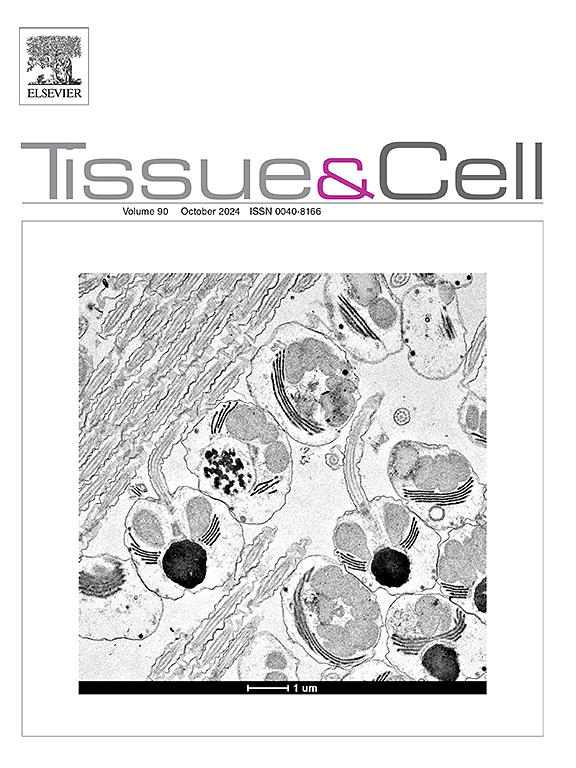3D traction force microscopy in human trabecular meshwork tissues: Effects of ROCK and YAP/TAZ inhibition in normal and glaucomatous tissues
IF 2.7
4区 生物学
Q1 ANATOMY & MORPHOLOGY
引用次数: 0
Abstract
Primary open-angle glaucoma (POAG) is the leading cause of irreversible blindness worldwide, with an estimated 112 million people projected to be affected by 2040. The primary risk factor for POAG is elevated intraocular pressure (IOP), which is primarily driven by increased resistance to aqueous humor outflow through the conventional outflow pathway. Despite its prevalence, the precise biomechanical mechanisms underlying this resistance remain unclear. In this study, we utilized 3D in situ traction force microscopy to investigate the effects of the rho kinase (ROCK) inhibitor Y-27632 and the YAP/TAZ inhibitor Verteporfin treatments on the trabecular meshwork (TM) and juxtacanalicular tissue (JCT) cellular contractility and their extracellular matrix (ECM) reorganization in both normal and glaucomatous human donor eyes. Our analysis revealed dysregulated traction forces within glaucomatous tissues, leading to significant ECM reorganization that may contribute to disrupting the homeostasis of the aqueous outflow pathway. Treatments appear to help restore normal ECM structure by adjusting cellular forces. The effect on contractile forces differed between genders, suggesting the significance of gender in treatment response. Our results suggest that targeting these biomechanical pathways may offer new therapeutic strategies to reduce outflow resistance, laying the groundwork for future therapies aimed at preserving vision by restoring ECM biomechanics and improving outflow.
人小梁网组织的三维牵引力显微镜:ROCK和YAP/TAZ抑制在正常和青光眼组织中的作用
原发性开角型青光眼(POAG)是全球不可逆转失明的主要原因,预计到2040年将有1.12亿人受到影响。POAG的主要危险因素是眼压升高(IOP),这主要是由于对房水通过常规流出途径流出的阻力增加所致。尽管其普遍存在,但这种抵抗的确切生物力学机制尚不清楚。在这项研究中,我们利用三维原位牵引力显微镜研究了rho激酶(ROCK)抑制剂Y-27632和YAP/TAZ抑制剂Verteporfin治疗对正常和青光眼人供眼小梁网(TM)和关节旁组织(JCT)细胞收缩性及其细胞外基质(ECM)重组的影响。我们的分析揭示了青光眼组织内牵引力失调,导致显著的ECM重组,这可能有助于破坏水流出通道的稳态。治疗似乎通过调节细胞力量来帮助恢复正常的ECM结构。对收缩力的影响在性别之间存在差异,提示性别在治疗反应中的重要性。我们的研究结果表明,针对这些生物力学途径可能提供新的治疗策略来减少流出阻力,为未来的治疗奠定基础,旨在通过恢复ECM生物力学和改善流出来保护视力。
本文章由计算机程序翻译,如有差异,请以英文原文为准。
求助全文
约1分钟内获得全文
求助全文
来源期刊

Tissue & cell
医学-解剖学与形态学
CiteScore
3.90
自引率
0.00%
发文量
234
期刊介绍:
Tissue and Cell is devoted to original research on the organization of cells, subcellular and extracellular components at all levels, including the grouping and interrelations of cells in tissues and organs. The journal encourages submission of ultrastructural studies that provide novel insights into structure, function and physiology of cells and tissues, in health and disease. Bioengineering and stem cells studies focused on the description of morphological and/or histological data are also welcomed.
Studies investigating the effect of compounds and/or substances on structure of cells and tissues are generally outside the scope of this journal. For consideration, studies should contain a clear rationale on the use of (a) given substance(s), have a compelling morphological and structural focus and present novel incremental findings from previous literature.
 求助内容:
求助内容: 应助结果提醒方式:
应助结果提醒方式:


